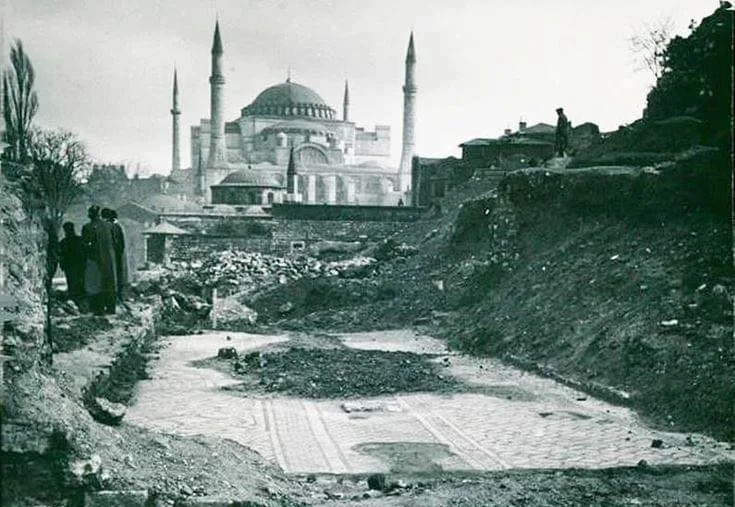Ottoman era Ishak Pasha Palace in Türkiye’s Agri draws record visitors
 View over the historical Ishak Pasha palace in Dogubeyazit, Agri, Türkiye. (AA Video)
View over the historical Ishak Pasha palace in Dogubeyazit, Agri, Türkiye. (AA Video)
Ishak Pasha Palace, a prominent Ottoman-era structure in the Dogubayazit district of Agri, drew a surge of visitors over the weekend.
The palace, celebrated for its stunning architecture and rich history, attracted tourists from various regions.
When was Ottoman era Ishak Pasha’s Palace in Agri built?
Built during the Ottoman Empire’s Tulip Era, Ishak Pasha Palace stands on a hilltop south of Dogubayazit, surrounded by rugged mountains. The palace complex includes a mosque, various rooms, walls, a tomb, inner and outer courtyards, a council hall and a harem.
UNESCO has included it on its World Heritage Tentative List, recognizing its historical and architectural value.
Bekir Camdere, visiting from Konya, expressed his admiration: “I love traveling and came here to see Agri’s historical beauties. We have been exploring for about two hours, and it is worth it.”
Visitors also explored nearby historical sites, such as the tomb of Islamic scholar Ahmed-i Hani, the Urartu Castle, the Ahmed-i Hani Museum and the Old Bayezid Mosque.
Construction, design of Ishak Pasha Palace
Colak Abdi Pasha of the Cildir Atabeks began the construction of Ishak Pasha Palace in 1685. His descendant, Kucuk Ishak Pasha, completed it in 1784. The palace spans 377 by 164 feet and consists of terraces and various architectural elements, built in both one-story and multi-story sections.
The design blends Ottoman and Seljuk architectural styles and reflects European Baroque influences.
The palace’s most notable features include its ornate entrance gate, courtyards, and central heating system, reminiscent of modern radiators that warm the structure. The single-domed mosque within the palace is adorned with a minaret of two different colored stones, adding to its unique appearance.
The northern facade of the palace, with wooden corbels featuring winged dragons, lions, and human figures, showcases intricate artistic craftsmanship.
Despite some sections being in ruins, the palace has undergone partial restorations. The mosque remains one of the most intact parts of the complex. Ishak Pasha Palace is an architectural marvel representing the region’s historical and cultural richness.
What is there to do in Agri’s Ishak Pasha Palace?
Tourists visiting the palace can delve into local legends and tales. Renowned Turkish writer Yasar Kemal described the tragic love story of Gulbahar and Ahmed in his works, adding a layer of mystique to the palace. Kemal wrote (originally in Turkish): “Gulbahar lost Ahmed at Kup Lake. Since that day, those who pass by Kup Lake will see Gulbahar sitting on the shore of the lake, her long black hair flowing like light on her back, her head between her hands and her eyes staring at the pure blue water.”
The palace’s captivating ambiance and storied past offer a unique experience, drawing both local and international visitors alike. The site provides a glimpse into the architectural prowess of the Ottoman era and serves as a cultural and historical journey for those who visit.
How to visit Ishak Pasha Palace in Agri
Located just 4.3 miles (6.9 kilometers) southeast of Dogubayazit, Ishak Pasha Palace is easily accessible. A short drive from Dogubayazit, along the direction of Dogubeyazit Castle, brings visitors to this historical site. The palace remains open daily except Mondays, welcoming visitors from 9:30 a.m. to 7:00 p.m., with the last ticket sold at 18:30.
The palace complex, covering 81,806 square feet, includes all essential elements of a palace, such as courts, meeting places, a bakery, a dungeon, a hammam, a mosque, a room for the harem section, the men’s quarter, a mausoleum, a kitchen, service rooms, and stables.
The architectural style combines Ottoman and Seljuk styles, with some parts being one-story and others two- or three-story.
Visitors also enjoy exploring the surrounding areas, including the nearby tomb of Sheikh Ahmedi Hani, a great Islamic scholar. The palace offers a comprehensive view of Ottoman architecture and the region’s cultural heritage.
Ishak Pasha Palace continues to attract tourists with its historical significance, architectural beauty, and cultural richness. The palace, which was crucial during the late 18th century, symbolizes the Ottoman Empire’s architectural achievements and cultural heritage.



